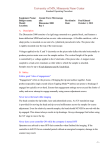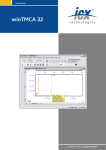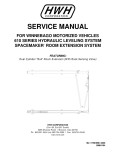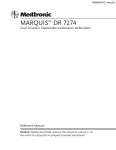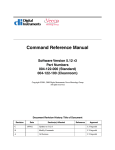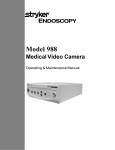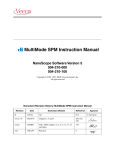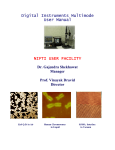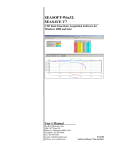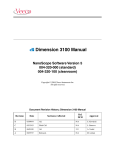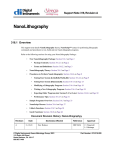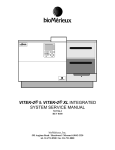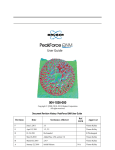Download Electrostatic Force Microscopy - Nano & Pico Characterization Lab
Transcript
Support Note No. 230, Rev. A Electric Force Microscopy (EFM) Applicable to Dimension™ Series Systems Support Note Table of Contents 230.1 Electric Force Microscopy Overview 2 230.1.1 Electric Field Gradient Imaging Overview 4 230.1.2 Surface Potential Imaging Overview 4 230.2 Electric Field Gradient Detection—Theory 4 230.3 Electric Field Gradient Detection—Preparation 7 230.3.1 Jumper Configurations for Systems Without the Extender Electronics Module 9 A: Field Gradient Imaging—Voltage Applied to the Tip 10 B: Field Gradient Imaging—Voltage Applied to the Sample 11 C: Field Gradient Imaging—External Voltage Source Applied to the Tip 12 D: Field Gradient Imaging—External Voltage Source Applied to the Sample 13 230.3.2 Jumper Configurations For Microscopes With the Extender Electronics Module 14 E: Field Gradient Imaging—Voltage Applied to the Tip 15 F: Field Gradient Imaging—Voltage Applied to the Sample 16 G: Field Gradient Imaging—External Voltage Source Applied to the Tip 17 H: Field Gradient Imaging—External Voltage Source Applied to the Sample 18 230.4 Electric Field Gradient Detection—Procedures 19 230.4.1 Phase Detection 20 230.4.2 Amplitude Detection 23 With Extender Electronics Module 23 Without Extender Electronics Module 23 230.5 Surface Potential Detection—Theory 25 230.6 Surface Potential Detection—Preparation 26 230.6.1 Applying Voltage to the Sample Indirectly 28 230.6.2 Applying Voltage to the Sample Directly 29 230.7 Surface Potential Imaging—Procedure 30 230.7.1 Troubleshooting the Surface Potential Feedback Loop 33 Document Revision History: Support Note: 229 © Digital Instruments, 1996 520 E. Montecito St. Santa Barbara, CA 93103 (805)899-3380 Rev. Date Rev. A 24MAY96 Section(s) Initial Release Ref. DCR Approval 0062, 0110 230-1 Electric Force Microscopy—Dimension Series Support Note No. 230 230.1 Electric Force Microscopy Overview1 This support note describes how to perform electric force microscopy (EFM) imaging on a Dimension series system. Similar to magnetic force microscopy (MFM)— and sharing many of it’s procedural techniques—this mode utilizes the Interleave and LiftMode procedures discussed in the product instruction manual. (The MFM techniques can be found in Support Note #229. Contact Digital Instruments for a copy of this document.) Please read those sections prior to attempting electric force measurements. All standard Dimension-series SPMs are capable of EFM imaging using amplitude detection techniques. By adding an Extender™ electronics module (see Figure 14.2), the Dimension system may also be used for frequency modulation or phase detection, giving improved results. Amplitude detection has largely been superseded by frequency modulation and phase detection. This hardware unit is required for surface potential imaging, and is strongly recommended for electric field gradient imaging. Two types of electric force microscopy are available using the Dimension Series system: 1) electric field gradient imaging; and, 2) surface potential imaging. Each of the electric field measurement techniques are based on a two-pass LiftMode measurement. LiftMode allows the imaging of relatively weak but longrange magnetic and electrostatic interactions while minimizing the influence of topography (see Figure 230-1). Measurements are taken in two passes (each consisting of one trace and one retrace) across each scanline. First, topographical data is taken in TappingMode on one trace and retrace. The tip is then raised to the final scan height, and a second trace and retrace performed while maintaining a constant separation between the tip and local surface topography. Both methods of electric force measurement are explained in this support note. 1. This support note describes how to perform electric force microscopy (EFM) imaging on a Dimension series system and replaces Support Note 206, Magnetic & Electric Force (MFM & EFM) Imaging with SPMs—Dimension-series Microscopes. Support Note 229 provides information on magnetic force microscopes (MFM) for Dimension series systems and Support Note 231 provides information on EFM for MultiMode™ systems. 230—2 Support Notes Support Note No. 230 Electric Force Microscopy—Dimension Series ➂ Force Gradient Scope Data (Interleave scan) 1521 ① ➁ Topographic Scope Data (Main scan) Electric Fields 1. Cantilever measures surface topography on first (main) scan. 2. Cantilever ascends to lift scan height. 3. Cantilever follows stored surface topography at the lift height ab sample while responding to electric influences on second (interleave scan. Figure 230-1 EFM LiftMode Principles Figure 230-2 Extender™ Electronics Module—required for frequency phase detection MFM and EFM. Support Notes 230—3 Electric Force Microscopy—Dimension Series Support Note No. 230 230.1.1 Electric Field Gradient Imaging Overview Electric field gradient imaging is a technique which measures variations in the electric field gradient above a sample. The sample may be conducting, nonconducting, or mixed. Since the electric field gradient is also shaped by the surface topography (e.g. sharp points on the surface concentrate the field gradient), large differences in topography can make it difficult to distinguish electric field variations. In general, the best samples for electric field gradient imaging are samples that have applied voltages of roughly 1 volt or more, samples with fairly smooth topography, or samples with trapped charge. Samples with insulating layers (passivation) on top of conducting regions may also be good candidates for electric field gradient imaging. 230.1.2 Surface Potential Imaging Overview Surface potential imaging measures the effective surface voltage of the sample by adjusting the voltage on the tip so that it feels a minimum electric force from the sample. (In this state, the voltage on the tip and sample is the same.) Samples for surface potential measurements should have an equivalent surface voltage of less than ±10 volts, and operation is easiest for voltage ranges of ±5 volts. The noise level of this technique can be as low as a few mV. Samples may consist of conducting and nonconducting regions, but the conducting regions should not be passivated. Samples with regions of different materials will also show contrast due to contact potential differences. Semi-quantitative voltage measurements can be made on samples if the system is carefully calibrated on a sample at a known voltage. This method requires the Extender Electronics Module and version 3.1 or later of the NanoScope III software. For more information regarding installation of the Extender Electronics Module, see sections at the end of this support note. 230.2 Electric Field Gradient Detection—Theory Electric field gradient imaging is analogous to standard MFM, except that gradients being sensed are due to electrostatic forces. In this method, the cantilever is vibrated by a small piezoelectric element near its resonant frequency. The cantilever’s resonant frequency changes in response to any additional force gradient. Attractive forces make the cantilever effectively “softer,” reducing the cantilever resonant frequency. Conversely, repulsive forces make the cantilever effectively “stiffer,” increasing the resonant frequency. A comparison of these force additives is shown in Figure 230-3. 230—4 Support Notes Electric Force Microscopy—Dimension Series Amplitude Support Note No. 230 ∆F0 Amplitude Frequency Attractive gradient equivalent to additional spring in tension attached to tip, reducing the cantilever resonance frequency. ∆F0 Frequency Repulsive gradient equivalent to additional spring in compression attached to tip, increasing the cantilever resonance frequency. Figure 230-3 Comparison of Attractive and Repulsive Forces to Action of a Taught Spring Attached to the Tip Changes in cantilever resonant frequency can be detected in one of the following ways: • Phase detection—with Extender Electronics Module only. • Frequency modulation (FM)—with Extender Electronics Module only. • Amplitude detection—not recommended due to artifacts. All of the above methods rely on the change in resonant frequency of the cantilever due to vertical force gradients from the sample. Figure 230-4 shows a diagram of how the Extender Electronics module provides the signal enhancement and feedback allowing gradient detection. The best candidates for electric field gradient imaging are samples that have large contrasts in the electric force gradient due to material differences or regions at substantially different potentials (voltage differences of 1.0 or more). For other samples having rough surface topography or small voltage variations, this technique may be undesirable because topographic features will appear in the LiftMode image. Support Notes 230—5 Electric Force Microscopy—Dimension Series Support Note No. 230 Cantilever Deflection Signal Photodiode signal Conditioning RMS Detector Phase Detector Laser Beam Reference Signal Amplitude Signal Signals to NanoScope Phase Signal Servo Controller (Feedback loop adjusts oscillation frequency until phase lag is zero) Frequency Control lines Photodetector Frequency Signal High Resolution Oscillator Tapping Piezo Oscillator Signal Extender Electronics Module Sample Figure 230-4 Diagram of Extender Electronics Module in Phase and Frequency Measurement Mode Topographic features appear in the LiftMode image because local force gradients are heavily influenced by surface structure. That is, sharp features on sample surfaces concentrate the local force gradient. This happens on all roughness scales, so the local force gradient will also vary in much the same way as does the surface topography. Thus, electric field LiftMode images measured by amplitude, phase or frequency detection often show contrast that is very similar to the surface topography. Samples with rough surface topography or with smaller potential variations are more successfully imaged by the surface potential measurement method described below. NOTE: In most cases, it is necessary to apply a voltage across the tip or sample to achieve a high-quality image. Various methods for applying voltages to the tip and sample are included in the sections that follow. Samples with permanent electric fields may not require the application of voltage. 230—6 Support Notes Support Note No. 230 Electric Force Microscopy—Dimension Series 230.3 Electric Field Gradient Detection— Preparation This section explains how to conduct electric field gradient imaging by applying a voltage to the tip or sample to generate electric fields. If the sample being imaged has a permanent electric field which does not require the external application of voltage, the steps below are not required and you can proceed to Section 230.4. Note: Before attempting to reconfigure the jumpers, carefully read the following Jumper Configuration sections. When it is necessary to apply voltage to the tip or sample, minor changes must be made to the jumpers on the microscope’s backplane and the toggle switches on the Extender Electronics Module (if equipped). Original jumper configurations and jumper changes are dependent on the microscope being used and the measurements desired. Section 230.3.1 provides jumper configuration instructions for basic microscope models operating without the Extender Electronics Module (See: Jumper Configuration Sections A, B, C, D.). Section 230.3.2 provides jumper configuration instructions for basic microscope models operating with the Extender Electronics Module (See: Jumper Configuration Sections E, F, G, H.) The backplane board used with Dimension-series SPMs is shown below in Figure 230-5. At the center of the board is located a header supplied with jumpers. For non-EFM applications and surface potential operation, jumpers are usually left in their original positions or returned to their original positions. HEADER & JUMPERS Figure 230-5 Dimension-series Microscope Backplane. Jumpers are circled. Support Notes 230—7 Electric Force Microscopy—Dimension Series Support Note No. 230 1. Carefully examine the following figures and identify which jumper configuration, if any, is appropriate for your application. 2. Power down the NanoScope III controller and turn off all peripherals. Unplug the NanoScope III power cable from the microscope’s electronic box. 3. Remove the back panel on the microscope’s electronic box. Locate header and jumpers per Figure 230-5 on the main electronics backplane. As shipped from the factory, jumpers on systems without the Extender Electronics Module should appear as shown in Figure 230-6, whereas jumper systems with the Extender Electronics option should appear as in Figure 230-11.If the microscope is to be used for EFM imaging in cases where voltage is applied to the tip or sample, it is necessary to change the jumpers. 4. Depending upon whether voltage is to be applied to the tip or sample, and the amount of voltage to be used, reconfigure jumpers on the backplane header using the appropriate jumper configuration as shown in the appropriate sections below. 5. After the backplane jumpers are correctly configured, replace the cover on the electronics box. Apply power to the microscope and all peripherals. Boot the computer and start the NanoScope software. 6. If the backplane jumpers are configured to use an external voltage source, click on the Microscope / Calibrate / Detector option to display the Detectors Parameters window. Switch the Allow in attenuation field to Allow. 7. Imaging can now be accomplished using the procedures in Section 230.4. 230—8 Support Notes Support Note No. 230 Electric Force Microscopy—Dimension Series 230.3.1 Jumper Configurations for Systems Without the Extender Electronics Module As shipped from the factory, the jumper configuration on a Dimension-series system without the Extender Electronics Module should appear as shown in Figure 230-6 below. Sample Chuck Ground/Bias Sample Chuck AFM Tip Ground Analog 2 Gain Select Unused STM signal (from Dimension head) Auxiliary D (to NanoScope III controller) Ground Ground Indicates jumpers Figure 230-6 Normal Jumper Configuration For Systems Without the Extender Electronics Module As Shipped From Factory Support Notes 230—9 Electric Force Microscopy—Dimension Series Support Note No. 230 A: Field Gradient Imaging—Voltage Applied to the Tip The jumper configuration in Figure 230-7 connects the Analog 2 signal from the NanoScope III controller (± 12 VDC range) to the tip. Enabling the Analog 2 Voltage Line: The “Analog 2” voltage line is normally used by the NanoScope to control the attenuation (1x or 8x) of the main feedback signal. This application of EFM imaging uses the Analog 2 signal for EFM data. Therefore, input attenuation must be disabled for the duration of the EFM experiments. To do this, click on the Microscope / Calibrate / Detector option to display the Detectors Parameters window. Switch the Allow in attenuation field to Disallow. Return to the main Feedback Controls panel; the Analog 2 field should now be enabled. This signifies that voltage is now being supplied via the “Analog 2” pin located on the backplane header. Remember to restore (Allow in attenuation) upon completion of EFM imaging. Sample Chuck Ground/Bias Tip Sample Chuck Analog 2 Ground AFM Tip Analog 2 Gain Select Sample Unused STM signal (from Dimension head) Auxiliary D (to NanoScope III controller) Ground Ground Indicates jumpers Figure 230-7 Jumper Configuration for Application of Voltage to Tip (For Systems Without the Extender Electronics Module) 230—10 Support Notes Support Note No. 230 Electric Force Microscopy—Dimension Series B: Field Gradient Imaging—Voltage Applied to the Sample The jumper configuration in Figure 230-8 connects the Analog 2 signal from the NanoScope III controller (± 12 VDC range) to the sample chuck. Enabling the Analog 2 Voltage Line: The “Analog 2” voltage line is normally used by the NanoScope to control the attenuation (1x or 8x) of the main feedback signal. This application of EFM imaging uses the Analog 2 signal for EFM data. Therefore, input attenuation must be disabled for the duration of the EFM experiments. To do this, click on the Microscope / Calibrate / Detector option to display the Detectors Parameters window. Switch the Allow in attenuation field to Disallow. Return to the main Feedback Controls panel; the Analog 2 field should now be enabled. This signifies that voltage is now being supplied via the “Analog 2” pin located on the backplane header. Remember to restore (Allow in attenuation) upon completion of EFM imaging. Sample Chuck Ground/Bias Tip Sample Chuck AFM Tip Ground Analog 2 Sample Gain Select Analog 2 Unused STM signal (from Dimension head) Auxiliary D (to NanoScope III controller) Ground Ground Indicates jumpers Figure 230-8 Jumper Configuration for Application of Voltage to Sample (For Systems Without the Extender Electronics Module) Support Notes 230—11 Electric Force Microscopy—Dimension Series Support Note No. 230 C: Field Gradient Imaging—External Voltage Source Applied to the Tip In some cases, it may be advantageous to use voltages greater than 12 VDC, or to use a pulsed power supply. If an external source of voltage is to be applied to the tip, configure jumpers as shown in Figure 230-9. >10 MΩ (+) Sample Chuck Ground/Bias External Voltage Source Sample Chuck Tip AFM Tip Analog 2 Ground (-) + Gain Select Unused Sample V – STM signal (from Dimension head) Auxiliary D (to NanoScope III controller) Ground Ground Indicates jumpers Figure 230-9 Jumper Configuration for Applying External Voltage to Tip (For Systems Without the Extender Electronics Module) A current-limiting resistor (e.g., 10–100 MΩ) should be placed in series with the external voltage supply as shown to protect the tip and sample from damage. Current-limited power supplies may also be used. Voltage leads should be connected to pins on the header using soldered, push-on connectors. Do not solder leads directly to the header pins, as the heat may cause damage and/or make jumpering the pins difficult. 230—12 Support Notes Support Note No. 230 Electric Force Microscopy—Dimension Series D: Field Gradient Imaging—External Voltage Source Applied to the Sample In some cases, it may be advantageous to use voltages greater than 12 VDC, or to use a pulsed power supply. If an external source of voltage is to be applied to the sample, configure jumpers as shown in Figure 230-10. External Voltage Source (-) (+) Sample Chuck Ground/Bias >10 MΩ Sample Chuck Tip AFM Tip Ground Analog 2 Gain Select Unused Sample + >10 MΩ STM signal (from Dimension head) V – Auxiliary D (to NanoScope III controller) Ground Ground Indicates jumpers Figure 230-10 Jumper Configuration for Applying External Voltage to Sample (For Systems Without the Extender Electronics Module) A current-limiting resistor (e.g., 10–100 MΩ) should be placed in series with the external voltage supply as shown to protect the tip and sample from damage. Current-limited power supplies may also be used. Voltage leads should be connected to pins on the header using soldered, push-on connectors. Do not solder leads directly to the header pins, as the heat may cause damage and/or make jumpering the pins difficult. Support Notes 230—13 Electric Force Microscopy—Dimension Series Support Note No. 230 230.3.2 Jumper Configurations For Microscopes With the Extender Electronics Module Reminder: Power down the microscope and turn off all peripherals. Unplug the NanoScope III control and power cables from the system before attempting to adjust jumper configurations. As shipped from the factory, systems with the Extender Electronics option, should have an original backplane jumper configuration as shown in Figure 230-11. ChuckGround/Bias Chuck AFM Tip Ground Analog 2 or Gnd/OSC + DC signal Unused Unused STM signal Auxiliary 2 Output Ground Ground Indicates jumpers Figure 230-11 Normal jumper configuration as shipped from factory for Dimension systems with Extender Electronics Module installed. 230—14 Support Notes Support Note No. 230 Electric Force Microscopy—Dimension Series E: Field Gradient Imaging—Voltage Applied to the Tip Notice that the jumper configuration in Figure 230-12 connects the Analog 2 signal from the NanoScope III controller (± 12 VDC range) to the tip, and is exactly the same as the jumper configuration shown in Figure 230-11, the standard configuration as shipped from the factory. Enabling the Analog 2 Voltage Line: The “Analog 2” voltage line is normally used by the NanoScope to control the attenuation (1x or 8x) of the main feedback signal. This application of EFM imaging uses the Analog 2 signal for EFM data. Therefore, input attenuation must be disabled for the duration of the EFM experiments. To do this, click on the Microscope / Calibrate / Detector option to display the Detectors Parameters window. Switch the Allow in attenuation field to Disallow. Return to the main Feedback Controls panel; the Analog 2 field should now be enabled. This signifies that voltage is now being supplied via the “Analog 2” pin located on the backplane header. Remember to restore (Allow in attenuation) upon completion of EFM imaging. Chuck Ground/Bias Tip Sample Chuck AFM Tip Ground Analog 2 or Gnd/OSC + DC signal Analog 2 Sample Unused Unused STM signal Auxiliary 2 Output Ground Ground Indicates jumpers Figure 230-12 Jumper Configuration for Application of Voltage to Tip— Standard Configuration of Systems With the Extender Electronics Module as Shipped from Factory Support Notes 230—15 Electric Force Microscopy—Dimension Series Support Note No. 230 F: Field Gradient Imaging—Voltage Applied to the Sample The jumper configuration in Figure 230-13 connects the Analog 2 signal from the NanoScope III controller (± 12 VDC range) to the sample. Enabling the Analog 2 Voltage Line: The “Analog 2” voltage line is normally used by the NanoScope to control the attenuation (1x or 8x) of the main feedback signal. This application of EFM imaging uses the Analog 2 signal for EFM data. Therefore, input attenuation must be disabled for the duration of the EFM experiments. To do this, click on the Microscope / Calibrate / Detector option to display the Detectors Parameters window. Switch the Allow in attenuation field to Disallow. Return to the main Feedback Controls panel; the Analog 2 field should now be enabled. This signifies that voltage is now being supplied via the “Analog 2” pin located on the backplane header. Remember to restore (Allow in attenuation) upon completion of EFM imaging. Chuck Ground/Bias Sample Chuck Tip AFM Tip Ground Analog 2 or Gnd/OSC + DC signal Unused Sample Analog 2 Unused STM signal Auxiliary 2 Output Ground Ground Indicates jumpers Figure 230-13 Jumper Configuration for Application of Voltage to Sample (For Systems With the Extender Electronics Module) 230—16 Support Notes Support Note No. 230 Electric Force Microscopy—Dimension Series G: Field Gradient Imaging—External Voltage Source Applied to the Tip In some cases, it may be advantageous to use voltages greater than 12 VDC, or to use a pulsed power supply. If an external source of voltage is to be applied to the tip, configure jumpers as shown in Figure 230-14. >10 MΩ Chuck Ground/Bias Chuck AFM Tip Ground Analog 2 or Gnd/OSC + DC signal (+) (-) External Voltage Source Tip + Unused Unused Sample V – STM signal Auxiliary 2 Output Ground Ground Indicates jumpers Figure 230-14 Jumper Configuration for Applying External Voltage to Tip (For Systems With the Extender Electronics Module) A current-limiting resistor (e.g., 10–100 MΩ) should be placed in series with the external voltage supply as shown to protect the tip and sample from damage. Current-limited power supplies may also be used. Voltage leads should be connected to pins on the header using soldered, push-on connectors. Do not solder leads directly to the header pins, as the heat may cause damage and/or make jumpering the pins difficult. Support Notes 230—17 Electric Force Microscopy—Dimension Series Support Note No. 230 H: Field Gradient Imaging—External Voltage Source Applied to the Sample In some cases, it may be advantageous to utilize voltages greater than 12 VDC, or to utilize a pulsed power supply. If an external source of voltage is to be applied to the sample, configure jumpers as shown in Figure 230-15. External Voltage Source (-) (+) Chuck Ground/Bias >10 MΩ Chuck Ground AFM Tip Analog 2 or Gnd/OSC + DC signal Tip Unused Unused STM signal + Sample >10 MΩ V – Auxiliary 2 Output Ground Ground Indicates jumpers Figure 230-15 Jumper Configuration for Applying External Voltage to Sample (For Systems With the Extender Electronics Module) A current-limiting resistor (e.g., 10-100 MΩ) should be placed in series with the external voltage supply as shown to protect the tip and sample from damage. Current-limited power supplies may also be used. Voltage leads should be connected to pins on the header using soldered, push-on connectors. Do not solder leads directly to the header pins, as the heat may cause damage and/or make jumpering the pins difficult. 230—18 Support Notes Support Note No. 230 Electric Force Microscopy—Dimension Series 230.4 Electric Field Gradient Detection— Procedures NOTE: Amplitude detection is the only procedure described here that can be done without the Extender Electronics Module; however, this method is no longer recommended (see Section 230.4.2). 1. Locate the two toggle switches on the backside of the Extender Electronics box (Figure 230-16), then verify that they are toggled as shown in Table 230.1. Mode Tip or Sample Voltage FM/Phase Gnd/Surface Potential Surface Potential Mi To cro sc op To e Scop Nano Analog 2 e Figure 230-16 Toggle Switches on back of Extender Electronics Module Mode FM/Phase TappingMode Contact AFM MFM √ √ GND/Surface Potential Analog 2 √ √ Surface Potential Apply voltage to tip or sample (Use for electric field gradient imaging; tunneling AFM) Tip or Sample Voltage Surface Potential √ √ Table 230.1 Extender Electronics Module Toggle Switch Settings Support Notes 230—19 Electric Force Microscopy—Dimension Series Support Note No. 230 NOTE: The toggle switch combination of Surface Potential = ON and Analog2 = ON is not recommended and can produce erratic and undefined results. 2. Electrically connect the sample by mounting it to a standard sample disk or stage using conducting epoxy or silver paint. Ensure the connection is good; a poor connection will introduce noise. 3. Mount a metal-coated NanoProbe cantilever into the electric field cantilever holder. MFM-style cantilevers (225 micron long, with resonant frequencies around 70 kHz) usually work well. It is also possible to metal-coat standard TappingMode cantilevers. Make sure that any deposited metal you use adheres strongly to the silicon cantilever. 4. Set up the AFM as usual for TappingMode operation. In the Channel panels, be certain all Highpass and Lowpass filters are Off. Set the Rounding parameter in the Microscope / Calibrate / Scanner window to zero (0.00). 5. Select View / Cantilever Tune. 6. Follow the instructions below for the type of electric force imaging desired, Phase Detection or Amplitude Detection. 230.4.1 Phase Detection Phase Detection Phase Detection is only available when the Extender Electronics Module has been correctly configured into the system. • In the Cantilever Tune window, set Start frequency and End frequency to appropriate values for your cantilever (e.g., for 225 µm MFM cantilevers, set Start frequency to 40 kHz and End frequency to 100 kHz). Select Autotune. • Two curves appear on the Cantilever Tune graph: the amplitude curve in white, and the phase curve in yellow. (In Figure 230- 17, the phase curve is the dashed line and the amplitude curve is the solid line.). 230—20 Support Notes MFM / EFM Support Note No. 230 Electric Force Microscopy—Dimension Series Figure 230-17 Phase Detection Cantilever Tune (Extender Electronics Module Installed) The phase should decrease with increasing frequency and cross the center line (90° point) at the peak frequency. The phase curve then correctly reflects the phase lag between the drive voltage and the cantilever response. Again, gradients in the electric force will cause a shift ∆F0 in the resonance frequency. In this case, resonance shifts give rise to phase shifts ∆φ which can then give an image of the electric force gradients; see Figure 230-18. 180 Phase (deg) ∆F0 90 ∆φ 0 Drive Frequency Figure 230-18 Shift In Phase at Fixed Drive Frequency Support Notes 230—21 Electric Force Microscopy—Dimension Series Support Note No. 230 • Under Interleave Controls set the Lift start height to 0 nm, and Lift scan height to 100 nm. (The lift height can later be optimized.) Set the remaining Interleave parameters (Setpoint, Drive amplitude, Drive frequency, and gains) to the main Feedback Controls values. This can be done by setting the flags (left of the Interleave Control column) to “off” (grayed bullets). • • Quit Auto Tune and return to Image Mode Engage the AFM and make the necessary adjustments to obtain a good topography (Height) image on Channel 2. • Select the Interleave Controls panel. Set the Setpoint, Drive amplitude, Drive frequency to Main (“off” grayed bullets). Verify that Interleave scan is set to Lift. • Choose a Lift scan height of 100 nm. This will be optimized later. Set the Channel 1 image Data type to Phase and choose Retrace for the scan Line direction on both Channel 1 and 2 images. • Switch Interleave mode to Enable to start LiftMode. Set the Channel 1 Scan line to Interleave to display interleave data. This screen should now display the cantilever phase change due to electrical force gradients from the sample in the left image and topography in the right image. • Optimize the Lift height. For high-resolution, make the Lift scan height as small as possible without crashing the tip into the surface. If the tip crashes into the surface it creates bright or dark streaks across the image. Also, if the Lift scan height is set extremely low, the tip may continuously “tap” on the surface during the LiftMode scan. Check this by toggling between the Interleave and main scan lines for the phase image. The two images will look very similar if the tip is continuously tapping on the surface during the LiftMode scan. In this case, increase the Lift scan height until the Interleave scan image abruptly changes, indicating that it is now oscillating above the surface and not continuously tapping. • Adjust the sample or tip voltage to confirm that contrast is due to electrical force gradients. On very rough samples, contrast in LiftMode images may be from air damping between the tip and surface. It is often useful to look at the phase data in Scope Mode while adjusting the tip or sample voltage up and down. Contrast due to electrical force gradients should increase or decrease as the tip-sample voltage is changed. • For more quantitative results, switch the to the frequency Data Type for Channel 1. This technique provides a direct measure of the change in resonant frequency felt by the cantilever. It may be necessary to optimize the FM (frequency modulation) gain to properly track the shifts in resonant frequency. This is described in detail in Chapter 13 of the appropriate product instruction manual. 230—22 Support Notes Support Note No. 230 Electric Force Microscopy—Dimension Series 230.4.2 Amplitude Detection Amplitude Detection With Extender Electronics Module MFM / EFM To set up for Amplitude Detection field gradient imaging on systems with the Extender module installed, follow the instructions in Section 230.4.1, Phase Detection, with the exception that the Channel 1 Data Type should be set to Amplitude.) Without Extender Electronics Module Note: This imaging method, although described here, is not recommended without the Extender Electronics module due to the presence of artifacts. Amplitude Detection, unlike Phase Detection, is available with or without the optional Extender Electronics Module. This section describes the differences in software set up and imaging for EFM systems without the Extender module. When EFM imaging without the Extender module, changes in the cantilever amplitude provide an indirect measure of shifts in the cantilever resonance frequency as shown in Figure 230-19. Amplitude ∆F0 Drive Frequency Figure 230-19 Shift In Amplitude at Fixed Drive Frequency (Extender Electronics Module not installed.) • Set the Drive frequency to the left side of the cantilever resonance curve, as shown in Figure 230-20. Support Notes 230—23 Electric Force Microscopy—Dimension Series Support Note No. 230 Figure 230-20 Amplitude Detection Cantilever Tune (Extender Electronics Module not Installed) • For maximum sensitivity, set the Drive frequency to the steepest part of the resonance curve. As the tip oscillates above the sample, a gradient in the magnetic force will shift the resonance frequency F0; (see Figure 230-19). Tracking the variations in oscillation amplitude while in LiftMode yields an image of the electric force gradients. Either side of the resonance may be used, though we have obtained slightly better results on the low side, as shown in Figure 230-19. • When using Amplitude Detection, optical interference may sometimes appear in the lift (magnetic force) image when imaging highly reflective samples. Optical interference appears as evenly spaced, sometimes wavy lines with about 1–2µm spacing superimposed on the lift image. This occurs when ambient laser light (i.e., light passing around or through the cantilever, then reflecting off the sample) interferes with laser light reflecting from the cantilever. Interference can be alleviated by moving the beam spot up the cantilever away from the tip; about one-third of the cantilever length from the tip usually works well. On the Dimension head, the adjustment can be refined by carefully moving the beam spot laterally on the cantilever while scanning until interference fringes are minimized. NOTE: Optical interference is essentially eliminated by using Phase Detection or Frequency Modulation, available only with the Extender Electronics Module. 230—24 Support Notes Support Note No. 230 Electric Force Microscopy—Dimension Series 230.5 Surface Potential Detection—Theory NOTE: Surface potential detection EFM is only possible using the Extender Electronics Module. This section does not apply to microscopes which are not equipped with the Extender Electronics Module. The Extender Electronics Module allows measurement of local sample surface potential. This is similar to techniques called Scanning Maxwell Stress Microscopy and Kelvin Probe Microscopy. Surface potential detection is a two-pass system where the surface topography is obtained in the first pass and the surface potential is measured on the second pass. The two measurements are interleaved, that is, they are each measured one line at a time with both images displayed on the screen simultaneously. A block diagram of the surface potential measurement system is shown in Figure 230-21. On the first pass, the sample topography is measured by standard TappingMode. In TappingMode the cantilever is physically vibrated near its resonant frequency by a small piezoelectric element. On the second pass, the piezo that normally vibrates the cantilever is turned off. Instead, to measure the surface potential, an oscillating voltage V ac cos ωt is applied directly to the cantilever tip. This creates an oscillating electrostatic force at the frequency ω on the cantilever. The oscillating force has the following amplitude: dC F = ------- V dc V ac dz dC where ------- is the vertical derivative of the tip/sample capacitance. dz V dc = V tip – V sample , the dc voltage difference between the tip and the sample, and V ac is the amplitude of the oscillating voltage applied to the cantilever tip. Support Notes 230—25 Electric Force Microscopy—Dimension Series Support Note No. 230 Cantilever Deflection Signal Photodiode Signal RMS Detector Amplitude Signal Lock-in Amplifier Reference Signal Laser Beam Photodetector Tapping Piezo To Tip DC Voltage Sum AC Servo Controller Signals to NanoScope (Feedback loop adjusts DC tip voltage to zero lockin signal) Potential Signal Sample Oscillator Signal GND High Resolution Oscillator Extender Electronics Module Figure 230-21 Simplified Block Diagram of Extender Electronics Module in Surface Potential Mode. The key here is that the force on the cantilever depends on the product of the ac drive voltage and the dc voltage difference between the tip and the sample. And, when the tip and sample are at the same dc voltage (Vdc=0), the cantilever will feel no oscillating force. The Extender Electronics Module uses this fact to determine the effective surface potential on the sample, Vsample. The Extender determines the local surface potential by adjusting the dc voltage on the tip, Vtip, until the oscillation amplitude becomes zero. At this point the tip voltage will be the same as the unknown surface potential. The voltage applied to the cantilever tip Vtip is recorded by the NanoScope III to construct a voltage map of the surface. 230.6 Surface Potential Detection—Preparation It is often desirable to apply a voltage to one or more areas of a sample. This may be done in two ways: by connecting a voltage to the sample mounting chuck, or by 230—26 Support Notes Support Note No. 230 Electric Force Microscopy—Dimension Series making direct contact to the sample. In both cases, jumper configurations on the backplane of the microscope must be changed to match the environment desired. NOTE: In addition to any reconfigured jumpers, remember to connect the common or negative terminal of an external power supply to the Dimension system ground. Access to ground and other Dimension signals is also made by removing the back panel of the electronics box, as shown in the jumper configuration drawings below. 1. Power down the NanoScope controller and turn off all peripherals. Unplug the NanoScope power cable from the microscope’s electronic box. 2. Remove the back panel on the microscope’s electronic box. Locate jumpers on the main electronics backplane panel per Figure 230-5. As shipped from the factory, the backplane jumpers should appear as shown in Figure 230-11 and reproduced here (Figure 230-22) for convenience. ChuckGround/Bias Chuck AFM Tip Ground Analog 2 or Gnd/OSC + DC signal Unused Unused STM signal Auxiliary 2 Output Ground Ground Indicates jumpers Figure 230-22 Normal jumper configuration as shipped from factory for Dimension systems with Extender Electronics Module installed. 3. Depending upon whether voltage is to be applied to the sample directly or indirectly, reconfigure jumpers on the backplane header according to either Figure 230-23 or Figure 230-24 below. Support Notes 230—27 Electric Force Microscopy—Dimension Series Support Note No. 230 230.6.1 Applying Voltage to the Sample Indirectly When voltage is to be applied to the sample via the sample chuck for indirect surface potential imaging, configure the jumpers as shown in Figure 230-23. External Voltage Source (-) (+) Chuck Ground/Bias Chuck AFM Tip Ground Analog 2 or Gnd/OSC + DC signal >10 MΩ Unused Unused STM signal Auxiliary 2 Output Ground Ground Indicates jumpers Figure 230-23 Jumper Configuration for Application of Voltage to Sample via Sample Chuck A current-limiting resistor (e.g., 10–100 MΩ) should be placed in series with the external voltage supply to protect the tip and sample from damage. Current-limited power supplies may also be used. Voltage leads should be connected to pins on the header using soldered, push-on connectors. Do not solder leads directly to the header pins. Heat may cause damage and/or make jumpering the pins difficult. The sample should be electrically connected directly to the chuck or a standard sample puck using conductive epoxy or silver paint as shown below: Conductive Epoxy or Paint Sample Sample Chuck 230—28 Support Notes Support Note No. 230 Electric Force Microscopy—Dimension Series 230.6.2 Applying Voltage to the Sample Directly If voltage is to be applied directly to the sample, configure jumpers as shown in Figure 230.24. Chuck Ground/Bias Indicates jumpers Sample Chuck AFM Tip Ground Analog 2 or Gnd/OSC + DC signal Unused Unused STM signal Auxiliary 2 Output Ground Ground Connection to Power Supply Common or negative terminal (See below). Figure 230-24 Jumper Configuration for Application of Voltage Directly to Sample The sample should be electrically insulated from the chuck. Connect the external voltage source directly to the sample by attaching fine gauge wire to appropriate contacts (e.g., on integrated circuits connect electrical leads directly to pads). For normal operation, the sample chuck is held at ground; be certain to carefully insulate any electrical connections from the sample chuck. >10 MΩ External Voltage Source Sample Electrical Insulator Sample Chuck Support Notes 230—29 Electric Force Microscopy—Dimension Series Support Note No. 230 230.7 Surface Potential Imaging—Procedure 1. Locate the two toggle switches on the backside of the Extender Electronics box (Figure 230-25), then verify that they are toggled as shown in Table 230.2. Mode Tip or Sample Voltage FM/Phase Gnd/Surface Potential Surface Potential Mi To cro sc op To e Scop Nano Analog 2 e Figure 230-25 Toggle Switches on back of Extender Electronics Module : Mode FM/Phase TappingMode Contact AFM MFM √ √ GND/Surface Potential Analog 2 √ √ Surface Potential Apply voltage to tip or sample (Use for electric field gradient imaging; tunneling AFM) Tip or Sample Voltage Surface Potential √ √ Table 230.2 Extender Electronics Module Toggle Switch Settings For Surface Potential Imaging NOTE: The toggle switch combination of Surface Potential = ON and Analog2 = ON is not recommended and can produce erratic and undefined results. 230—30 Support Notes Support Note No. 230 Electric Force Microscopy—Dimension Series 2. Mount a sample onto the Dimension’s stage. Make any external electrical connections that are necessary for the sample. 3. Mount a metal-coated NanoProbe cantilever into the electric field cantilever holder. MFM-style cantilevers (225 micron long, with resonant frequencies around 70 kHz) usually work well. It is also possible to deposit custom coatings on model FESP silicon TappingMode cantilevers. Verify that all deposited metal adheres strongly to the silicon cantilever. 4. Set up the AFM as usual for TappingMode operation. 5. Use Cantilever Tune: AutoTune (as described in Section 230.4.1) to locate the cantilever’s resonant peak. Remember, however, that the Extender box has been reconfigured so that the phase detection circuitry now acts as a lock-in amplifier. Any procedures that are normally used to view or adjust the phase signal will now affect the lock-in signal instead (see Figure 230-21). In this case, two curves should appear in the Cantilever Tune box: the amplitude curve in white and the lock-in curve in yellow. In the event you find more than one resonance, select a resonance that is sharp and clearly defined, but not necessarily the largest. It is also helpful to select a resonant peak where the lock-in signal also changes very sharply across the peak. Multiple peaks can often be eliminated by making sure the cantilever holder is clean and the cantilever is tightly secured. 6. Engage the AFM and make the necessary adjustments for a good TappingMode image while displaying height data. 7. Select the Interleave Controls command. This brings up a new set of scan parameters that are used for the interleaved scan where surface potential is measured. Different values from those on the main scan may be entered for any of the interleaved scan parameter. To fix any of the parameters so they are the same on the main and interleave scans, click on the green bullets to the left of particular parameter. The green bullet changes to “off” (gray) and the parameter value changes to the main Feedback Controls value. Set the interleave Drive frequency to the main feedback value. Enter an interleaved Setpoint of 0 V. Set Interleave scan to Lift. 8. Enter an Interleave Controls Drive amplitude. This is the ac voltage that is applied to the AFM tip. Higher Drive amplitude produces a larger electrostatic force on the cantilever and this makes for more sensitive potential measurements. Conversely, the maximum total voltage (ac + dc) that may be applied to the tip is ±10 V. So a large Drive amplitude reduces the range of the DC voltage that can be applied to the cantilever. If the sample surface potentials to be measured are very large, it is necessary to choose a small Drive amplitude, while small surface potentials can be imaged more successfully with large Drive amplitudes. To start choose a Drive amplitude of 5 V. Support Notes 230—31 Electric Force Microscopy—Dimension Series Support Note No. 230 9. Set the Channel 2 image Data type to Potential. Set the scan Line direction for the main and interleave scans to Retrace. Remember to choose the Retrace direction because the lift step occurs on the trace scan and data collection occurs on the retrace. 10. Choose a Lift start height of 0 nm and a Lift scan height of 100 nm. The Lift scan height can be readjusted later. 11. Switch Interleave mode to Enable to start LiftMode. Now, when the microscope completes a topographic scan line (trace and retrace) the system turns off the TappingMode piezo and switches the oscillator signal to the cantilever. The cantilever is driven electrostatically according to the interleave Drive amplitude that has been selected. Also, when Potential is selected as the Data type for the Channel 2 image, a feedback circuit is enabled in the Extender box which adjusts the dc voltage on the tip to maintain the cantilever oscillation amplitude at zero. To do this, the feedback circuit uses the lock-in signal of the cantilever oscillation and tries to keep this value at zero volts. As detailed in the Section 230.5 above, when the cantilever oscillation amplitude has returned to zero, the dc voltage on the tip and sample are the same. The NanoScope records the dc voltage applied to the tip and this signal is displayed in the Potential data type. 12. Adjust the FM gains. The feedback loop that is used by the Extender Electronics for surface potential measurements is the same as the one used in Frequency Modulation (FM) for magnetic and electric force gradient detection, as described previously. The feedback loop should be tuned in a similar manner to the FM setup. Select Other Controls and adjust the FM gains. Setting both FM Integral gain and FM Proportional gain to 15.0 is a good starting point. As with the topography gains, the scan can be optimized by increasing the gains to maximize feedback response, but not so high that oscillation sets in. The gains often need to be much lower for potential measurements than for standard FM measurements. More information on tuning the feedback loop is given in the Troubleshooting section below. 13. Optimize the Lift heights. Set the Lift scan height at the smallest value possible that does not make the Potential feedback loop unstable or cause the tip to crash into the sample surface. When the tip crashes into the surface during the Potential measurement, dark or light streaks appear in the Potential image. In this case, increase the Lift scan height until these streaks are minimized. 14. For large sample voltages or qualitative work, select Data type = Phase instead of Potential. When the Extender box has been configured for surface potential measurements, the “phase” signal is actually the cantilever amplitude signal, as measured by a lock-in amplifier. If the feedback loop is not enabled by selecting the Data type = Potential, the lock-in cantilever amplitude depends on the voltage difference between the tip and sample in a roughly linear fashion. (The lock-in amplifier produces a voltage that is proportional to the cantilever amplitude.) Qualitative 230—32 Support Notes Support Note No. 230 Electric Force Microscopy—Dimension Series surface potential images can be collected using this lock-in signal. Also, if the sample has a surface potential that exceeds ±10 V (greater than the range of the “Potential” signal), it is possible to use the lock-in signal to provide qualitative images that reflect the sample surface potential. To view the lock-in signal with the reconfigured Extender box, select the Data type = Phase. 230.7.1 Troubleshooting the Surface Potential Feedback Loop The surface potential signal feedback loop can be unstable. This instability can cause the potential signal to oscillate or become stuck at either +10 V or -10 V. Here are some tips to see if the feedback loop is working properly with no oscillation: • Go into Scope Mode and look at the Potential signal. If oscillation noise is evident in the signal, reduce the FM gains. If oscillations persist even at very low FM gains, try increasing the Lift scan height and/or reducing the Drive amplitude until oscillation stops. If the tip crashes into the surface the Lock-in signal becomes unstable and can cause the feedback loop to malfunction. Increasing the Lift height and reducing the Drive amplitude can prevent this problem. Once oscillation stops, the FM gains may be increased for improved performance. • In Scope Mode, if the Potential signal is perfectly flat and shows no noise even with a small Z-range, the feedback loop is probably stuck at ±10 V. (You can verify this by changing the value of Realtime planefit to None in the Channel 1 panel.) Reduce the Scan rate and watch the display monitor which indicates the cantilever amplitude. On the topographic trace, the voltage displayed should be the setpoint selected for the Main scan. On the Potential trace, this voltage drops close to zero if the cantilever oscillation is being successfully reduced. If the value on the display monitor instead goes to a large nonzero value, the feedback loop is probably not working properly. In this case, try reducing the Drive amplitude and increasing the Lift scan height. It may also be helpful to momentarily turn the Interleave mode to Disabled, then back to Enabled. Also try reducing any external voltage that is being applied to the sample to stabilize the feedback loop, then turn the voltage back up. Support Notes 230—33



































